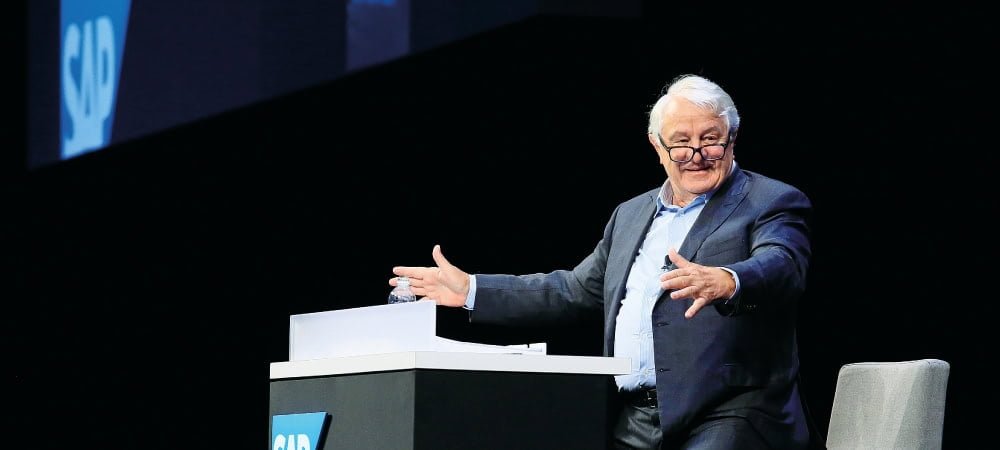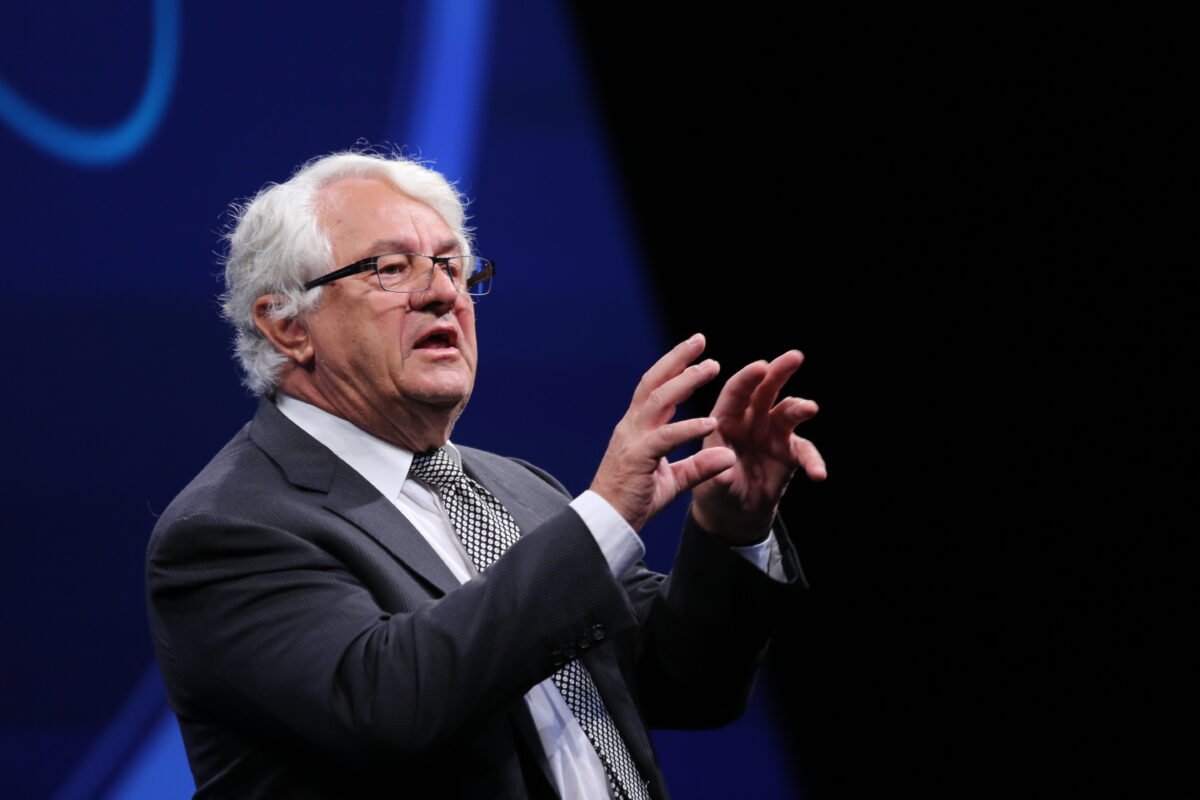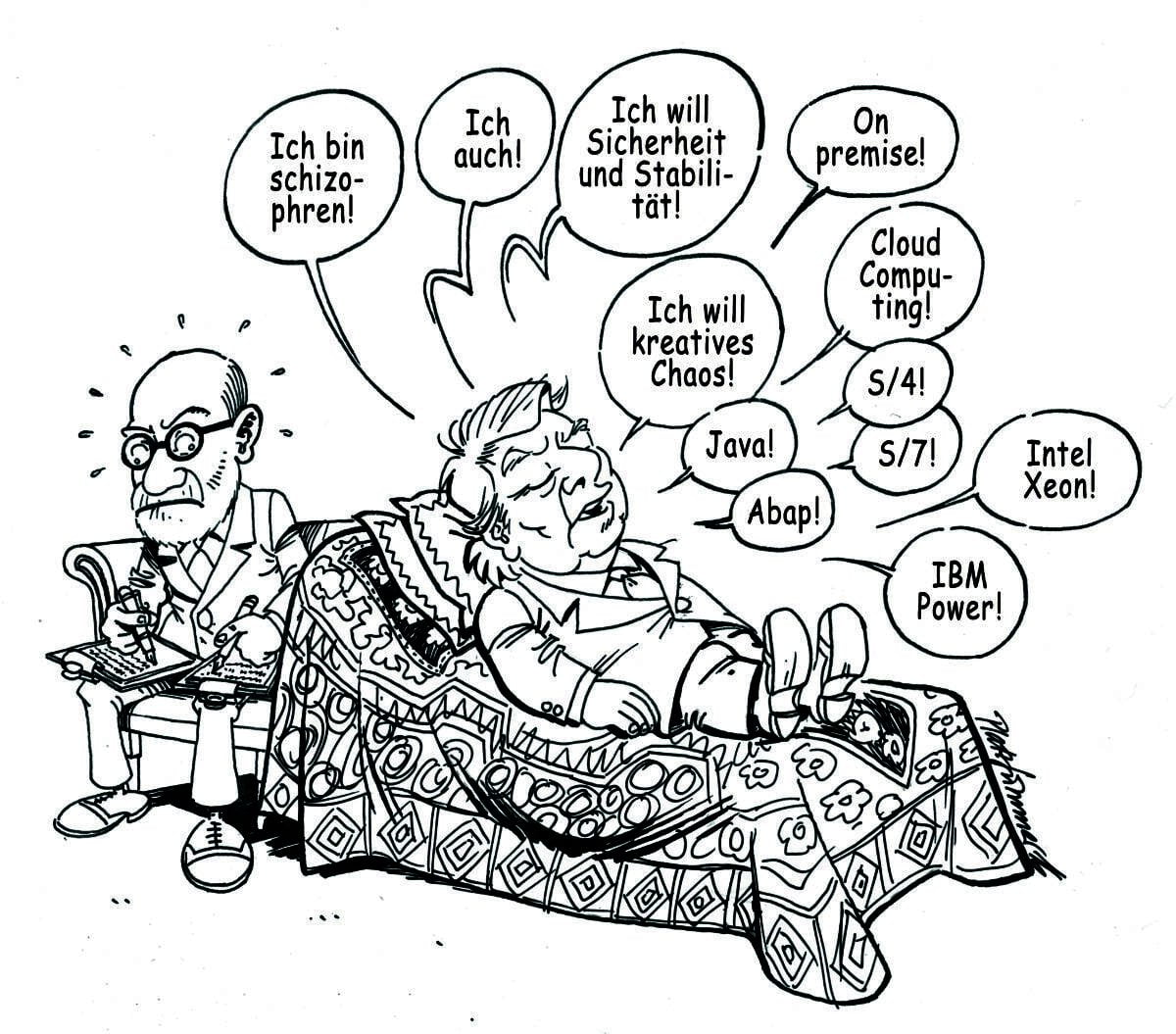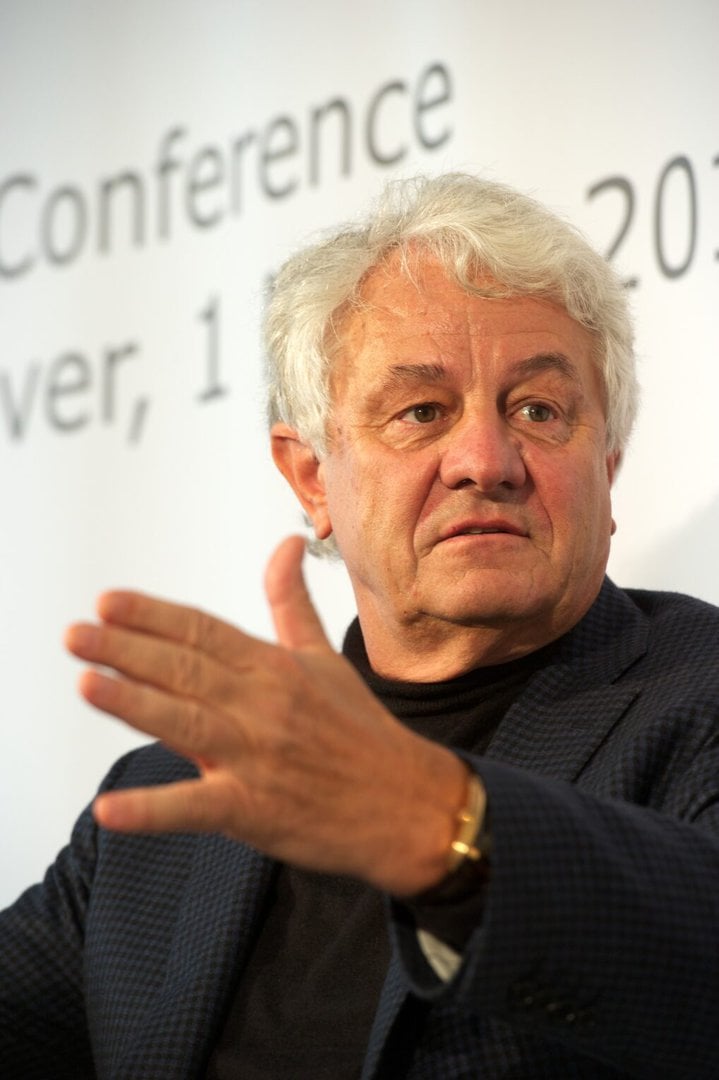SAP's disruptive innovation


The lack of compliance was often mentioned during Plattner's time in office as Chairman of the Supervisory Board, but Plattner was committed to the task itself and not to a bureaucratic position description.
Professor Hasso Plattner was the innovator and visionary at SAP. He is responsible for many of SAP's product innovations. His last big idea was the in-memory computing database Hana. Editor Michael Kroker from the German-language weekly magazine WiWo asked Hasso Plattner in an exclusive interview: What's one dream that didn't materialize? Plattner: "My last project that I drove forward technologically at SAP was the high-performance database Hana. I hoped that SAP would manage to bring Hana to the top of this segment because it was by far the best database at the time. The market should actually reward that somehow; however, SAP didn't quite manage it."
Hana achieved a respectable working speed because the data was not stored on slow hard disks, but in the main memory of the server. This required high investments in server memory, but enabled an ERP system that could respond to user queries almost in real time. In the meantime, computer technology has developed so rapidly that SAP Hana's speed advantage over competing products from Oracle, IBM and Microsoft has been marginalized. WiWo editor Michael Kroker asked in his exclusive interview: Why didn't it succeed? Plattner: "I honestly don't know. Because the price for Hana was too high? At the time, SAP didn't want to give a discount on Hana. After all, Hana is now the basis of all SAP products and is very successful, but it has not established itself as an independent database as I expected."
The failure of the Hana database can be explained in terms of market policy and technology. However, the high license price of Hana, as Hasso Plattner suggested in the WiWo interview, does not appear anywhere as an inhibiting factor. Rather, the failure of Hana can be explained by a public dispute between Harvard professor Clayton M. Christensen and Professor Hasso Plattner, which took place on June 4, 2014 on the stage of SAP's in-house trade fair Sapphire Orlando. Plattner defended Hana as a disruptive innovation. He saw his database as the pinnacle of computer science.
Professor Clayton M. Christensen from Harvard Business School is the author of the management bible "The Innovator's Dilemma". In his successful book, Christensen uses numerous examples to illustrate the difficulty that corporations have in keeping up with new ideas and young companies. The book, which is well worth reading, culminates in a key point: "If a company tries to develop a disruptive technology to the point where it meets the requirements of customers in established markets - which most leading companies do - it is almost certain to fail."
Plattner and Christensen 2014
On the Sapphire stage in 2014, Christensen tried to make it clear to his colleague Professor Hasso Plattner that the SAP database is probably a high-quality product idea and will help many existing SAP customers, but that the approach that this is a disruptive innovation is probably counterproductive for SAP. Christensen's key point can also be read in this way: If SAP tries to develop a potentially disruptive technology such as the Hana database to the point where it meets the requirements of existing SAP customers in established markets - which SAP is obviously now planning to do - SAP is almost certain to fail.

The two professors were unable to reach an agreement on the open Sapphire stage. Plattner wanted to be recognized as a disruptive computer scientist with the supposed innovation Hana, while Christensen remained calm and consistent in his teaching opinion. They parted without compromise and Hana never saw the light of a free and open IT scene. Hana became the carrier of SAP's next ERP generation S/4 and will continue to remain in this niche. A relaunch of Hana seems hopeless.
The current Hana 2.0 revision 77 also contains serious errors and there are still no updates and software fixes. SAP ignores many Hana issues and is therefore trapped in its own system. Instead of business solution competence, the company has exhausted itself in technical repair service behavior. SAP CEO Christian Klein claimed that he only hears good and positive things about Hana from his existing customers. However, the SAP Basis teams of existing customers no longer have an overview of the numerous Hana fixes and updates that are rolled out by SAP on a weekly basis. Hana still suffers from data inconsistency with versions SPS-6 Revision 60, 61 and 62 - SAP also warns about this in the relevant SAP Notes. Admittedly, it is very technical.
New database for S/4
It is no trivial task for a complex ERP system such as R/3, ECC 6.0 or S/4 to develop an agile, stable and functioning database. Some members of the SAP community may still remember the Microsoft disaster with the SQL Server version 7 database. Back then, people were working day and night in Walldorf (SAP) and Seattle (Microsoft) because the database had massive errors and jeopardized the business of existing SAP customers. In the meantime, the Microsoft SQL server has reached a level of maturity so that this database can also be used in high-availability scenarios. However, this level of maturity was not achieved overnight and Hana is therefore far too young to match the quality of Oracle, IBM and Microsoft. One day it will be ready, but it will take time and until then, repair service behavior is the order of the day.

Perhaps the strangest anecdote in the short history of Hana since 2011 is the surprising departure of SAP Chief Technology Officer Vishal Sikka in 2014. After SAP Chief Technology Officer Shai Agassi, Sikka was Plattner's second "foster son" on the SAP Executive Board. However, the real reasons for Vishal Sikka's departure remain a mystery to this day. Many insiders suspect that it was due to the final positioning of Hana. Apparently, Vishal Sikka wanted to launch a public domain version of Hana on the market in order to position the database in non-SAP areas. It is not known whether Hasso Plattner or the SAP management was against this. The fact is, however, that if SAP had marketed its own database in a similar way to the underlying Linux operating system, SAP would have had to forgo many millions of euros in license revenue.
Even if Hana has so far failed to excite many computer scientists and has driven many SAP customer’s CFOs to despair over the double DB license fees, it has been a resounding commercial and strategic success for SAP itself. Now SAP no longer has to share the ERP community with Oracle, IBM, and Microsoft. The entire ERP stack is in the hands of SAP. The final vendor lock-in has reached its crowning conclusion with Hana and S/4.
Hana is a good SQL database, which is based on an in-memory computing
technology can provide selected answers in real time. Hana is 15 years young and other database providers have now caught up technically. Hana's real-time advantage has been squandered. What now? A Spiegel report on Hasso Plattner's departure from the SAP Supervisory Board by Tim Bartz and Christian Bergmann begins: "The billionaire's work is historic. His legacy is potentially toxic. After more than 50 years, founder Hasso Plattner is leaving the SAP software group - Germany's only world-class technology giant. But what will become of the giant without its dazzling founder?"
Intellectual Property
Several question marks hover over the Hana database, which is increasingly becoming a burden for the ERP group: There is a copyright and intellectual property dispute with Teradata in the USA; there is the displeasure of existing SAP customers regarding double license payments; and there are the high Hana fees when developing inexpensive apps on the BTP (SAP Business Technology Platform). Whether SAP wanted to deceive existing customers with the Hana ERP database will probably never be answered. The fact is, however, that SAP earns a lot of license fees with Hana and most existing SAP customers have to pay double DB fees over a longer period of time without being able to benefit twice.
In previous SAP release changes, existing customers were able to keep their database. In many cases, only a version change at ERP level was necessary. The database could be upgraded to a new version sooner or later. With the transition to SAP S/4, existing customers must also use the Hana database - the disruptive innovation!
The ERP release change is now accompanied by a database change, which is not only a double challenge for the SAP Basis team. The CFO also has to dig deep into his pockets, as database fees for the previous ERP with AnyDB (Oracle, Microsoft or IBM) as well as Hana have to be paid during the entire conversion period. Even if an S/4 conversion can technically be carried out within a few weeks, the entire ERP release change can take several years. During the S/4 conversion period, the existing SAP customer must operate and pay for their old ERP system (usually SAP Business Suite 7 with AnyDB) as well as S/4 Hana. However, there is no economic benefit from the double payment of DB fees.
Junction optimization: Hana and S/4
Ultimately, Hasso Plattner's disruptive innovation is an ominous combination of ERP and database. Junctionization is a legal technique for negotiating contracts or laws. The fact is: without one, the other is not possible. Anyone who chooses S/4 must also accept Linux as the operating system and Hana as the database. SAP derives a double benefit from this: In addition to the S/4 license revenue, there are now also fees for Hana and support becomes much easier for SAP. Now there is no need to service multiple combinations of different operating systems, databases and ERP versions, just the stringent IT architecture of Linux, Hana and S/4.

He foresaw many IT developments early on and led his SAP to become the global ERP market leader.
SAP is currently earning a lot of money with Hana, but it is not yet clear whether this will work out in the future. There are very interesting development concepts for Fiori apps on the SAP Business Technology Platform with CAP and RAP. In many cases, it is obvious to use the Hana database for these applications, but this entails additional and sometimes very high DB fees. Inexpensive low-code app development suddenly becomes uneconomical due to the high Hana license fees. In the short term, SAP earns very well (see also share price), but in the long term, Hana and S/4 could motivate many existing SAP customers to rethink (see Professor Clayton M. Christensen).
Reset with SAP CEO Christian Klein
In an extensive report, the German Manager Magazin got to the heart of SAP's desolate situation: the departure of Professor Hasso Plattner is forcing SAP CEO Christian Klein to reset. A year ago, the future of SAP still seemed bright: Christian Klein would have had a mentor for the successful future of SAP in the then designated Chairman of the Supervisory Board Punit Renjen. Plattner leaves and SAP loses relevance: Is there a connection here?
Because Professor Plattner listened more to his friends, colleagues and networks, Plattner's designated successor was dismantled at the beginning of this year. For many SAP executives and supervisory board members, an activist chairman would have been a threat to their own careers. Punit Renjen would have provided a lot of supervision and even more advice. He would have made an excellent SAP Supervisory Board Chairman, as Professor Hasso Plattner emphasized several times a year ago.

The upcoming Plattner successor and SAP Supervisory Board Chairman is a lame duck, so SAP CEO Christian Klein can do as he pleases. Klein is using this unique selling point for a reset, as the German Manager Magazin explains in great detail. It is pure desperation. Plattner said in the WiWo exclusive interview: "My successor Pekka Ala-Pietilä is a rabbit we pulled out of the hat. I have known him for a long time and am very much in agreement with him. I'm also sure that the same thing won't happen as before." Plattner will therefore be succeeded for two years not by Punit Renjen, but by Pekka Ala-Pietilä.
Despite all the criticism of SAP, more than half of the members of the German-speaking SAP User Group (DSAG) believe that the relevance of the software manufacturer for the future of their company will remain the same. "It is certainly also due to the fact that the software manufacturer has strongly penetrated the system landscapes of companies over the past decades. Replacing existing SAP systems is hardly conceivable in many companies simply because of the effort involved," concludes DSAG Chairman Jens Hungershausen. However, the industry association sees significant potential for expansion at SAP when it comes to supporting companies with their transformation projects.
Punit Renjen vs. Pekka Ala-Pietilä
For SAP CEO Christian Klein, transformation, consolidation, and orchestration have been a failure. With the departure of Professor Hasso Plattner and the removal of Punit Renjen as chairman of the supervisory board, Klein has lost all possible mentors. His own Executive Board is too heterogeneous and inexperienced to support the CEO—everyone is busy around the clock. Alone at home, Christian Klein hits the reset button.
Plattner's invention Hana was not his first in-memory computing database. But even the second attempt is more of a technical curiosity than a useful ERP tool. At least it brings SAP a lot of revenue in the S/4 conversion age. However, the future does not appear bright. Hana's biggest enemies are the SAP Business Technology Platform, SAP Datasphere and, of course, open source. SAP had high hopes for Hana. After more than ten years of the in-memory computing database, the result is a sad balance sheet. Hana is not a universal genius, nor is it a unique selling point or a disruptive innovation, as alternative data management is gaining in importance. The time for reorientation and alternatives has begun.
At the Hasso Plattner Institute at the University of Potsdam, Professor Plattner and his students once thought more deeply about what a future ERP might look like. One central idea was a new response time behavior in real time, i.e. an ERP system that does not keep the user waiting. And Hasso Plattner fell for the trick with the in-memory computing database. The new database had to be universally usable for all SAP modules and systems and always be able to provide answers in real time. An SQL in-memory computing database was developed at the Hasso Plattner Institute.

Who invented it? Not the Swiss herbal confectionery Ricola, but the in-memory computing database Hana. Plattner claims the disruptive innovation for himself.
It was a brilliant move by SAP to only offer Hana as a database for the ECC successor S/4 with the open source operating system Linux. With SAP R/3 and Business Suite 7 (ERP/ECC 6.0), not only SAP itself did excellent business, but naturally also the operating system and database providers. Oracle and IBM in particular enjoyed high database sales without any significant sales effort. Hasso Plattner said at a CeBIT press conference over 20 years ago that he was focusing on the entire value chain - from the desktop to the server. The result can now be seen after many years: from Fiori to Linux and Hana to S/4 and the SAP BTP IT platform, the claim to power is seamless. Or is it?
In the current transition phase from ECC with AnyDB to S/4 and Hana only, SAP is making a very good profit because many existing customers have been using their Microsoft, IBM and Oracle systems for years.
databases, where SAP also earns a lot of money, as well as having to pay the corresponding licenses for Hana. Many existing SAP customers are currently paying double database fees.
Naturally, Hana cannot fulfill the promise of a real-time ERP system. Those who can afford it now have all their data in the main memory of the S/4 server, which sensationally accelerates analytical queries. Every data warehouse solution benefits from Hana in an unprecedented way. SAP users are rejoicing! But just as many ERP functions are independent of a theoretical database speed. Other factors determine the response time behavior, so that the very expensive data storage using Hana in the S/4 main memory does not bring any benefit. SAP's existing customers pay for expensive Hana licenses without any discernible countervalue. The innovator's dilemma has fully struck at SAP!
Relevance of SAP
In a webinar by PAC, the French IT market researchers with an office in Munich and exclusive SAP knowledge, an audience member asked the question: How does SAP take into account the IT trend towards compos-
able Architecture and how does SAP intend to remain relevant in this market trend? Whether SAP is and will remain relevant in a market that Professor August-Wilhelm Scheer addresses in his book "Composable Enterprise" would have been considered blasphemy and an insult to majesty a few years ago. The question currently arises: after the Internet (at the turn of the millennium), after AI (see the phenomenal failure of SAP's Leonardo program a few years ago), is SAP now also missing out on the Composable Enterprise megatrend? Back in December 2021, the E3 editorial team, together with an Oracle executive, wrote the Cover story "Composability". SAP did not react to this, but ignored the topic until the end of 2023. Then Professor Scheer came along with the book: "Composable Enterprise: agile, flexible, innovative - game changer for organization, digitalization and enterprise software".
The coming months will show whether Professor Hasso Plattner's legacy is a game changer, a disruptive innovation or just the innovator's dilemma. His seat on the Supervisory Board remains empty, even if there is a formal successor. It was foreseeable from the start that no one would be able to replace Plattner, but a worthy successor looks different. This leaves it up to SAP CEO Christian Klein alone to lead the future of SAP to success with a reset.





